16 November 2018 to 3 March 2019
INTRODUCTION
Today, Ernst Ludwig Kirchner (1880–1938) is deemed to be one of the most important German artists. As a pioneer of German Expressionism and co-founder of the Brücke[Bridge] group of artists, he found new means to give expression to the societal changes taking place during the early 20th century.
Imaginary Travels traces Kirchner’s artistic development and his life-long search for the primal and authentic. By absorbing the widest range of influences, the artist arrived at a synthesis of art, life and work. This was mirrored both in his artistic output and in the environment—a Gesamtkunstwerk—that he created in which to live and work. Nonetheless, Kirchner never chose to travel to foreign lands. Instead, he spent his summers at the Moritzburg Lakes near Dresden or on the Baltic Sea island of Fehmarn.
In 1918, he went into self-imposed exile in Davos, Switzerland. Despite this, Kirchner’s oeuvre bears witness to the artist’s passionate encounter with non-European cultures. As a traveller in spirit, he studied ethnographic objects, in order to transmute them into a new formal language for use in his work. The photographs taken in some of his studios in Germany and Switzerland show exuberantly decorated, fascinating rooms furnished in a manner very unlike any bourgeois traditions then current. Kirchner made ‘exotic’ refuges for himself, that were simultaneously expressions of his creativity and sources of inspiration for him. He imagined exotic worlds into being in his art.
The Brücke Artists’ Group
Young Kirchner’s search for an ‘authentic’ and ‘primitive’ way of living, free of the accumulations and pressures of modern life, began in 1905. It was during that year, together with three other architecture students, Erich Heckel, Karl Schmidt-Rottluff and Fritz Bleyl, that he co-founded the artists’ group, Brücke. Working in close collaboration, the four students quickly discovered a shared passion that would definitively shape their artistic practice: an intense interest in the material culture of non-European civilisations. Whilst Max Pechstein travelled throughout the South Pacific, Emil Nolde took part in an expedition to New Guinea, and Erich Heckel and Karl Schmidt-Rottluff journeyed across Europe, Kirchner always remained in Germany and Switzerland.
The Nude
The depiction of the nude is a consistent theme through out Kirchner’s oeuvre. His fantasies about the ‘exotic’ and ‘alien’, above all, are mirrored in the numerous images of nudes in his early works, such as in

Negro Dancer*. The way in which he depicts the nude figure and her relaxed nakedness is inspired by ideas integral to the Lebensreform(life reform) movement. This alternative lifestyle was aimed at recreating a unity between human and nature. The theme of the ‘bather’ recurs constantly in Kirchner’s early works. He was able to free his art from the Classical motif of the nude, as seen in academic painting, in the natural environment he found at the Moritzburg Lakes and on Fehmarn, where he captured in his work the natural, candid movements and nudity of the primal human state. From today's perspective, the child models Lina Franziska (Fränzi) Fehrmann and Marzella Albertine Sprentzel are in some cases depicted in unacceptable sexualised poses inappropriate to their age.
The Nude

Ernst Ludwig Kirchner
Women Bathing (Triptych – Centre Panel)
1915/1925
Oil on canvas
© Kirchner Museum Davos
Ernst Ludwig Kirchner (1880–1938), co-founder of the Brücke artists’ group, is widely regarded as the most important German Expressionist painter. One of the leitmotifs of his life and work is the quest for the ‘exotic’ and the primal, for far-off lands and cultures. Although he never ventured beyond the borders of Germany and Switzerland, his work bears witness to his passionate engagement with non-European cultures. Responding to social and artistic influences, he broke new ground, both personally and pictorially and created strikingly colourful images that conjure vividly imagined far-away worlds.
Tracing the artist’s progress through Dresden, Berlin, Fehmarn and Davos, Imaginary Travels sheds light on Kirchner’s life and career from 1909 to his death in the Swiss mountains in 1938. A selection of international loans, above all from Switzerland and the United States, allows us to bring together motifs recurring throughout his oeuvre and to highlight the central importance Kirchner placed on working from the imagination.
Thanks to the co-operation of the Dresden Museum of Ethnology, this exhibition is the first to trace Kirchner’s visits to the ethnographic collection and the profound influence it had on his work and creative practice. Sketchbooks, letters and historical photographs are presented in the context of important events in the history of non-European cultures – as Kirchner would have seen them around the turn of the century.
The exhibition scrutinises Kirchner’s fervent enthusiasm for these cultures and addresses the complex issue of how to deal with the legacy of colonialism. Imaginary Travelspresents a comprehensive survey of Kirchner’s work after 1918, juxtaposing it with well-known early works of his time in Dresden and Berlin.
Kirchner’s late work in Switzerland in the late 1920s singles him out as an uncompromising, progressive artist, ceaselessly trying to give adequate expression to a constantly changing world. The exhibition brings together some 220 works – 56 paintings, 72 prints, four sketchbooks, ten sculptures, five textiles, 45 photographs as well as 26 ethnographic objects from 40 collections in seven countries.
Among the exhibits are numerous important and rarely shown works, such as the painting The Drinkerand Seated Girl (Fränzi Fehrmann), the bed Kirchner carved for his companion Erna Schilling and cast brass plaques from Benin. Rein Wolfs, director of the Bundeskunsthalle, sums up the exhibition, ‘Ernst Ludwig Kirchner is one of the most prominent German Expressionist artists.
The exhibition Imaginary Travels showcases his work and also addresses some of the more controversial aspects of his oeuvre, chief among them Kirchner’s appropriation of non-European cultures and his idealisation of Alpine Swiss popular culture.
The exhibition brings together numerous outstanding works, early as September 1915, Kirchner was temporarily discharged from military service due to mental illness on the intervention of his riding instructor, Professor Hans Fehr. The artist’s existential distress was mirrored in his self-portraits, and his photographs and portrait shots document his interrogation of this period of his life. In a letter to Gustav Schiefler dated 12 November 1916, he wrote, “The pressure of war, and superficiality run riot, weigh heavier than everything else. I always have the impression of a bloody carnival. How is it all supposed to end?”
STAYS IN THE SANATORIUM
The use of intoxicating substances had been widespread amongst literary figures and visual artists since the early 19th century. They were intended to overcome people’s inhibitions and increase their openness to new experiences. Aside from his alcohol and tobacco addictions, Kirchner suffered from insomnia, anxiety conditions and lung problems. His unchecked self-medication with morphine and Veronal, a barbiturate sleeping pill, and his lack of care for himself, due to sleep deprivation and excessive fasting, led to him staying on several occasions at sanatoria between 1915 and 1918.
Discharged from the military in November 1915 with the express order that he should take himself off to a clinic to convalesce, from December that year, Kirchner started a seven-month stay at Oskar Kohnstamm’s private sanatorium in Königstein im Taunus. After threatening suicide in December 1916, he was admitted to the closed ward at privy councillor, Dr Edel’schen Sanatorium for Depressive and Nervous Diseases in Charlottenburg in Berlin.
In mid-January 1917, Kirchner travelled to Davos for the first time and entrusted himself to the medical care of Dr Lucius Spengler and his wife Helene. A second stay followed in early May, during which Kirchner was put up in a cottage on the Stafelalp. From September, at the suggestion of his friend, Henry van de Velde, he spent 10 months at Dr Ludwig Binswanger’s Sanatorium Bellevue in Kreuzlingen, Switzerland, prior to his final return to Davos in 1918.
THE DAVOS YEARS
Kirchner finally withdrew to the Swiss mountains in 1918. In this landscape, and these people and their folk art, he found the authenticity and ‘primitive’ way of life, which he had been seeking since his time in Dresden, until then believing that he would only find it in non-European cultures. The Swiss mountains became the canvas onto which he was able to project these longings. In 1918, he moved into a house named ‘In den Lärchen’, and in 1923, he acquired a property known as ‘Wildboden’.
Kirchner’s intense encounter with his new home of Davos is most strikingly evident in the motifs of his paintings and woodcuts, and later in Lise Gujer’s woven carpets. He repeatedly drew upon visual subject matter from his immediate surroundings, linking peasant life and traditions with his expressive formal language and use of coloration. Many of the Alpine pictures can be definitively identified as Davos motifs, such as the Stafelalp, the town hall or the Wildboden.
THE STUDIO AS GESAMTKUNSTWERK
At the end of Kirchner’s first great period of creativity, between 1909 and 1914, his turn towards the imaginary really emerged. In 1911, he moved from Dresden to the metropolis of Berlin. He found painterly stimuli in the hurly-burly of the city and in like-minded people, with whom, in a Bohemian manner, he sought to create a fusion of art and the everyday. Although he consciously chose the metropolis as a place to live, he designed his studio as a refuge, a meeting place, a space to live and experiment and as somewhere to realise his unfettered lifestyle. With his friends, lovers and admirers, he created an alternative world countering the aesthetics of the Wilhelminian home.
The ideas of the Lebensreform movement, which sought to unify human and nature, became their guiding principles and provided Kirchner with a foundation for his unconventional lifestyle. Inspired by African artworks, Kirchner increasingly depicted the human body by employing simple, stylised forms. The black, female body, whether of a living model or of a museum artefact, was often used by the artist as inspiration. He instrumentalised these women’s bodies, in order to give expression to the ‘alien’ and ‘exotic’ in his work.
Kirchner accorded equal importance to his painting and sculptural work, and his paintings and sculpture were reciprocal in influencing one another. Works he had sculpted were often to be seen in his pictures. Non-European Influences The German Expressionists’ interest in non-European art was influenced, amongst other things, by the founding of German colonies in the South Pacific and in Africa and of new ethnographic museums.
Kirchner was struck and inspired by his reading of publications on ethnographic subjects and by his visits to the ethno logical museum in Dresden. He was entranced by the reconstructions of Sudanese and Samoan villages, idealised and romanticised from a European perspective, which were staged by Carl Marquardt as part of his ethnographical expositions at the Zoological Gardens in Dresden. Without taking into consideration the heinous atrocities that were being perpetrated in the colonies, Kirchner believed that he was being given authentic insight into what were then called ‘primitive’ peoples, in what in today’s view would be considered contemptuous and inhuman shows. Here, he thought, he was able to view people from these far-off lands ‘as seen in nature’, without having to travel himself.
The ethnographic collection in Dresden
The European tradition for collecting artefacts from all over the world reaches back to the 16th century and the cabinets of curiosities and art amassed by princes and scholars. Studies of natural history and culture at the Electoral Court of Saxony in Dresden were based predominantly on the comprehensive collections of gifts from foreign guests and envoys. It was these collections, which would form the basis of a museum, founded in 1878, with an anthropological and ethnographical focus.
Even in the early 20th century, the guiding principle of the museum was not only to document cultures from all corners of the world, but also to accord them due recognition. A conception of the Enlightenment, the notion that humankind and its cultural development were worthy of research did not automatically lead to an inhuman differentiation between cultures with the aim of asserting the cultural inferiority of other peoples. Nonetheless, elements of such a worldview increasingly came to the fore in connection with the economics of colonialism and the political nationalism of the time.
The illegal acquisition of cultural artefacts*, such as the skilfully cast or carved sculpture from the Kingdom of Benin, was also enabled by the violent colonialist occupation of foreign countries. It is one of the paradoxes of history that this questionable appropriation of non-European artworks would mean that they would be accorded international attention and world heritage status, neither of which they might otherwise have achieved. It is precisely because elements of the collections were acquired within a context of illegality that, aside from its importance as a locus for unparalleled knowledge creation and as a repository of learning, the local and international significance of the ethnological museum also lies in its function as a site of critical reflection and responsible cultural exchange.
* Commentary: today, the illegal appropriation of cultural artefacts is generally termed ‘looted art’.
Ernst Ludwig Kirchner
Garden Restaurant in Steglitz
1911/1912
Oil on canvas
LEBENSREFORM: FROM THE MORITZBURG LAKES TO FEHMARN
Towards the end of the 19th century, many movements critical of civilisation were called into being, which are now grouped together under the heading of Lebensreform (reform of life). They sought to return society to a much more natural way of life, intended to free people from the consequences of industrialisation —the so-called ‘ravages of civilisation’. For the young artists of the Brücke, this movement offered instruction and a theoretical foundation, an opportunity for self-reflection, a means to intensify sensory perception, and a way of freeing themselves from the superficial, decorative culture of the Empire. The (naked) body in a natural setting was seen as the ideal way of being. Thus, the Moritzburg Lakes near Dresden offered them a perfect environment for their artistic production. It was there that their swiftly executed free-hand sketches were made. The worked-up oil paintings are characterised by a warm palette of colours and brisk brushstrokes. The imaginary was the central focus of this work; in his depictions of archaic scenes, Kirchner was attempting to realise his vision of a primal lifestyle.
Moritzburg From 1904 onwards
Kirchner and his Brücke colleagues put their ideas about ‘primitive’ life to the test on their summer outings to the Moritzburg Lakes. With their bathing and naturism, liberated sexuality, archery and boomerang-throwing, they were seeking to draw nearer to the ideals of the Lebensreformmovement. What they experienced in doing so became the subject of numerous sketches and drawings. In a deliberate departure from academic drawing of the nude, the Brücke artists developed what they termed the “quarter-of-an-hour nude”. The models had to alter their postures after only fifteen minutes. The artists were not concerned to depict them in detail; it was more a question for them of swiftly capturing the models’ key characteristics and expressiveness. Because the young men wanted, above all, to record informal, natural movements they worked with their girlfriends and the child models, Lina Franziska (Fränzi) Fehrmann and Marzella Albertine Sprentzel. The women and children are shown frolicking around unclothed in the open air, sometimes even in sexualised poses inappropriate for the ages of the children.
Fehmarn
The outings into the open air, away from urban life and the familiar surroundings of the studio, were an enormous spur to Kirchner’s creative drive. After his first visit to the island of Fehmarn in 1908, he returned in 1912. He went to Staberhuk, in the south-eastern part of the island, where he took up residence in the attic room belonging to the lighthouse keeper, Mr Lüthmann. For the artist, these stays on the island were a natural extension of his search for a ‘primitive’ way of living. In the Fehmarn drawings, one can now see how he was able to capture in his confident lines, the relaxed nature of the bathing scenes and the undulating forms of the landscape of the bay.
Kirchner’s predilection for exoticising the bleak Baltic Sea landscape is evident in his paintings. A jungle-like wood can be seen in
| Colby CollegeMuseum of Art (Waterville, Maine)1912-1913 | |
| 1 |
Laburnum Tree, and
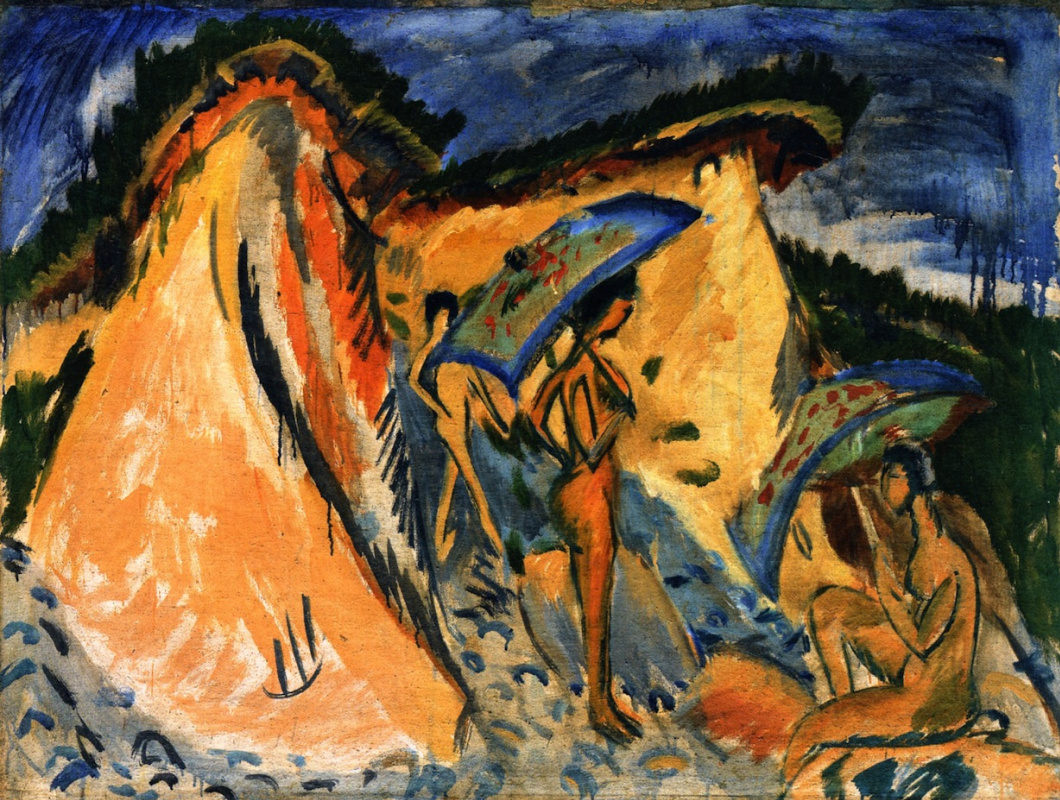
Fehmarn Dunes With Bathers Under Japanese Umbrellas. Museum: Kirchner Museum Davos.
Dunes on Fehmarn with Bathers under Japanese Umbrellas depicts a bathing scene typical of Kirchner—both are fantastical landscapes that invite the viewer to explore further. Many years later, Kirchner recalled that he often thought about his ‘earthly paradise’, mentioning it in letters to his friends and supporters.
‘BLOODY CARNIVAL’
The outbreak of the First World War forced Kirchner and Erna to end their last summer on Fehmarn, which was declared a strategically important zone. In 1915, Kirchner volunteered “unwillingly” for military service—in the hope of thus being able to influence where he was posted. He was conscripted to serve with the Mansfeld Field Artillery in Halle an der Saale. His early attraction to the military life gave way to anxiety and a strongly held opposition to the war.
As early as September 1915, Kirchner was temporarily discharged from military service due to mental illness on the intervention of his riding instructor, Professor Hans Fehr. The artist’s existential distress was mirrored in his self-portraits, and his photographs and portrait shots document his interrogation of this period of his life. In a letter to Gustav Schiefler dated 12 November 1916, he wrote, “The pressure of war, and superficiality run riot, weigh heavier than everything else. I always have the impression of a bloody carnival. How is it all supposed to end?”
Bloody Carnival
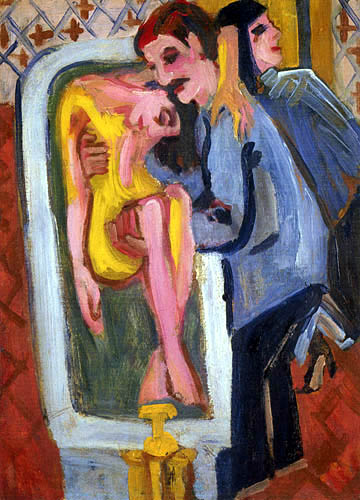
Ernst Ludwig Kirchner
The Patient’s Bath
1917
Oil on cardboard
Private collection
STAYS IN THE SANATORIUM
The use of intoxicating substances had been widespread amongst literary figures and visual artists since the early 19th century. They were intended to overcome people’s inhibitions and increase their openness to new experiences. Aside from his alcohol and tobacco addictions, Kirchner suffered from insomnia, anxiety conditions and lung problems. His unchecked self-medication with morphine and Veronal, a barbiturate sleeping pill, and his lack of care for himself, due to sleep deprivation and excessive fasting, led to him staying on several occasions at sanatoria between 1915 and 1918.
Discharged from the military in November 1915 with the express order that he should take himself off to a clinic to convalesce, from December that year, Kirchner started a seven-month stay at Oskar Kohnstamm’s private sanatorium in Königstein im Taunus.
After threatening suicide in December 1916, he was admitted to the closed ward at privy councillor, Dr Edel’schen Sanatorium for Depressive and Nervous Diseases in Charlottenburg in Berlin. In mid-January 1917, Kirchner travelled to Davos for the first time and entrusted himself to the medical care of Dr Lucius Spengler and his wife Helene. A second stay followed in early May, during which Kirchner was put up in a cottage on the Stafelalp. From September, at the suggestion of his friend, Henry van de Velde, he spent 10 months at Dr Ludwig Binswanger’s Sanatorium Bellevue in Kreuzlingen, Switzerland, prior to his final return to Davos in 1918.
THE DAVOS YEARS
Kirchner finally withdrew to the Swiss mountains in 1918. In this landscape, and these people and their folk art, he found the authenticity and ‘primitive’ way of life, which he had been seeking since his time in Dresden, until then believing that he would only find it in non-European cultures. The Swiss mountains became the canvas onto which he was able to project these longings. In 1918, he moved into a house named ‘In den Lärchen’, and in 1923, he acquired a property known as ‘Wildboden’. Kirchner’s intense encounter with his new home of Davos is most strikingly evident in the motifs of his paintings and woodcuts, and later in Lise Gujer’s woven carpets. He repeatedly drew upon visual subject matter from his immediate surroundings, linking peasant life and traditions with his expressive formal language and use of coloration. Many of the Alpine pictures can be definitively identified as Davos motifs, such as the Stafelalp, the town hall or the Wildboden.
The Davos years
Mandolin Player
1921
oil on canvas
© Kirchner Museum Davos,
photo: Kirchner Museum Davos, Jakob Jägli
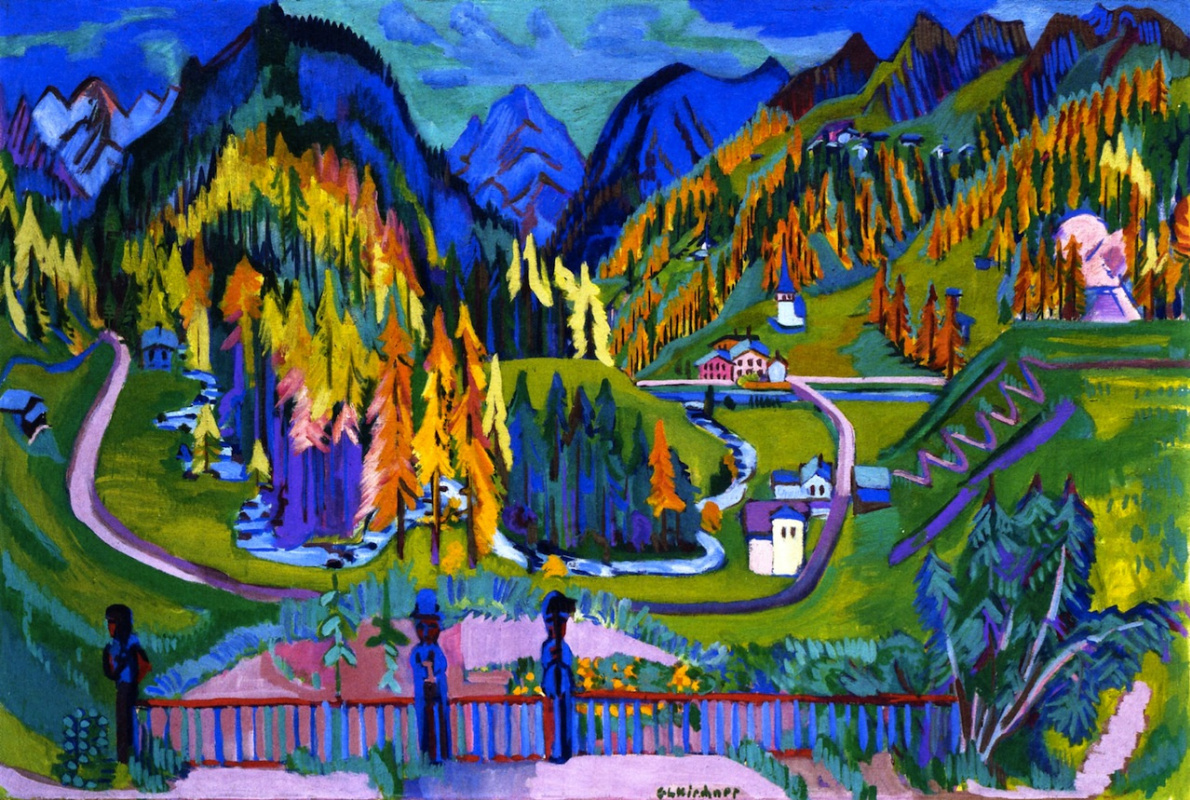
Ernst Ludwig Kirchner
Sertig Valley in Autumn
1925/1926
Oil on canvas
© Kirchner Museum Davos

Ernst Ludwig Kirchner
Life in the Alps, Triptych
1917–1919
Oil on canvas
© Kirchner Museum Davos, Jakob Jägli

Ernst Ludwig Kirchner
Elderly Alpine Herdsman Wearing a Black Hat – Kaspar Cadiepolt
1919
Woodcut
© Kirchner Museum Davos

Ernst Ludwig Kirchner
Two Goats
1919
Woodcut
© Kirchner Museum Davos,
photo Stephan Bösch
Ernst Ludwig Kirchner
The Three Old Women
1925/1926
Oil on canvas
© Kirchner Museum Davos
THE RENEWAL OF THE STUDIO AS GESAMTKUNSTWERK
Kirchner focused on the décor of his home in Davos, continuing the tradition he had created in his studios in Dresden and Berlin. His living room is shown as a refuge in his images. He repeatedly portrays its interior, which featured his own paintings, decorative drapery, carpets and sculptures, thus providing insight into his living space for later researchers. Nonetheless, the way in which he decorated his immediate surroundings underwent a marked development. It no longer related just to the internal space of his home, but also had an influence on its exterior appearance.
Kirchner carved the monumental sculptures, Adam and Eve, which flanked the door to his house, for instance, in native Swiss stone pine or larch wood. These figures are immortalised in the photograph, Nina Hard in front of the Entrance to the House ‘In den Lärchen’
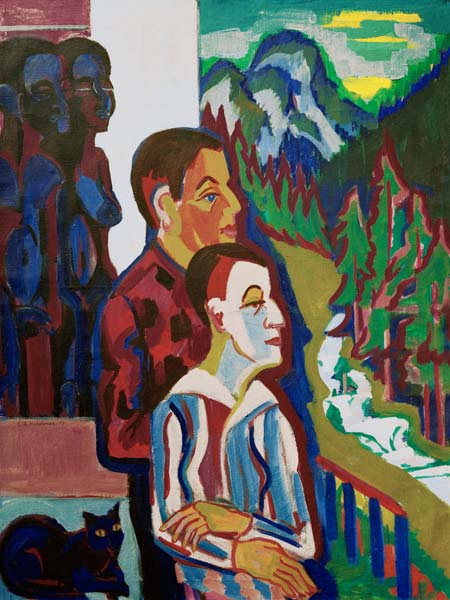
and in the painting, Before Sunrise.
The renewal of the studio as Gesamtkunstwerk
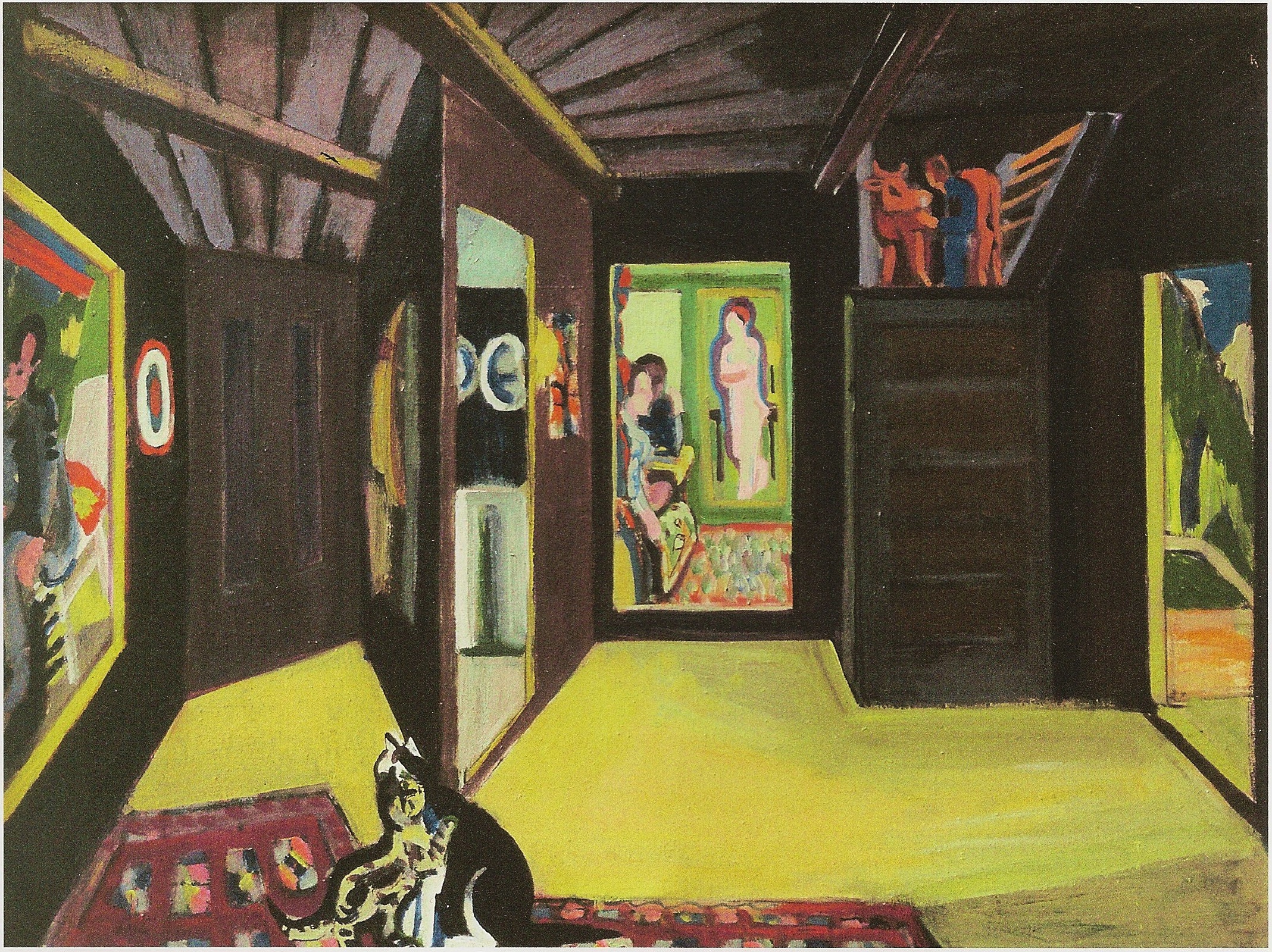
Ernst Ludwig Kirchner
Mountain Studio
1937
Oil on canvas
© Kirchner Museum Davos
Ernst Ludwig Kirchner und Lise Gujer
Kirchner’s fondness for textile art played an important role even when he was decorating his studio in Dresden. In Davos, he made the acquaintance of the Swiss weaver, Lise Gujer, who went on to fabricate carpets and wall-hangings according to his designs. The collaboration between Kirchner and Gujer is presumed to have begun around 1922 and it continued until the end of his life. They produced work in magnificent colours, the technique of weaving going on to have a long-term influence on Kirchner’s painting. It contributed significantly to his ‘New Style’.
Thanks to his interest in textiles for use in the home, Kirchner was ultimately able to facilitate the exhibition, and the sale under the name of Lise Gujer, of these woven works. He acted in the role of an intermediary, and vehemently disputed, despite the fact that the designs were his, that he was the creator of the textiles. As an independent artist, Gujer took the lead from Kirchner’s world of forms and ideas and rendered his artistic vocabulary via the medium of her work, amplifying it by employing her own stylistic devices. A close confidante of Kirchner’s, she safely stored his original sketches and templates, and his Davos diary, for posterity.
Ernst Ludwig Kirchner and Lise Gujer

Ernst Ludwig Kirchner and Erna Schilling
Erna and Nina Hard at the House 'In den Lärchen'
1921
embroidery
E. W. K., Bern / Davos
THE ‘NEW STYLE’
Kirchner’s predilection for monumental panoramas, already evident in his landscape painting of the 1920s, was the preparatory ground for his later planar style. This shift in his work originated in the textile works designed by Kirchner and executed by Lise Gujer. However, it also displayed influences drawn from Picasso’s Surrealist work, which Kirchner, always well-informed, saw at the Kunsthaus Zürich in 1932. This departure, which the artist himself termed his ‘new style’, was characterised by precise fields of colour, geometric compositions and stylised forms.
Powerful, prominent lines and light, shadow and movement depicted in a symbiotic unity represented Kirchner’s turning away from Expressionism and towards complex planar compositions. The significance of his immediate life and experiences also took second place during this new phase. Instead of the Davos motifs and its bucolic world, Kirchner’s work again depicted urban scenes. From his Davos home, he no longer painted his surroundings alone, but also drew on his memories of journeys to Frankfurt am Main, Dresden and Berlin during the winter of 1925–26.
The ‘New Style’
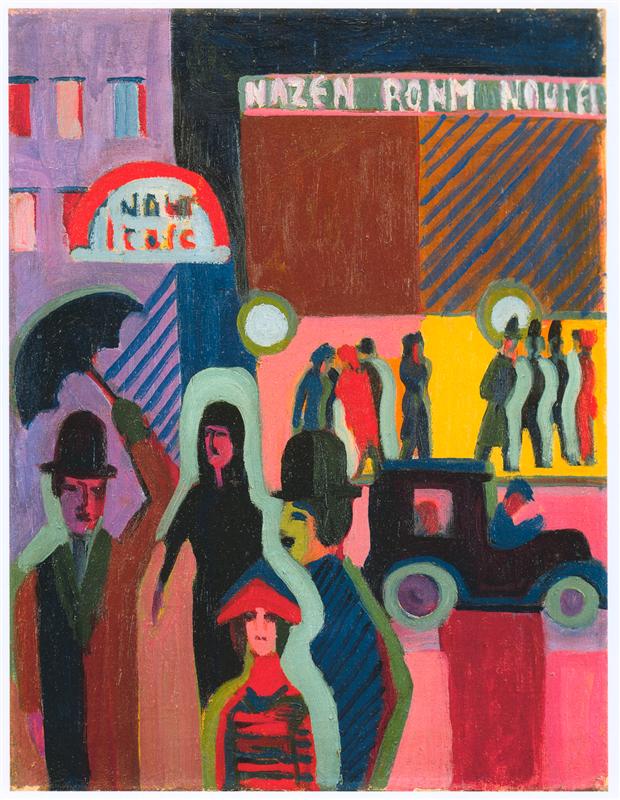
Ernst Ludwig Kirchner
Department Store in the Rain
1926/1927
Oil on canvas
© Kirchner Museum Davos

Ernst Ludwig Kirchner
Pair of Acrobats
1932–1933
Oil on canvas
© Kirchner Museum Davos, Jakob Jägli

Ernst Ludwig Kirchner
Three Nudes in the Woods
1933
Woodcut
© Kirchner Museum Davos,
photo: Kirchner Museum Davos